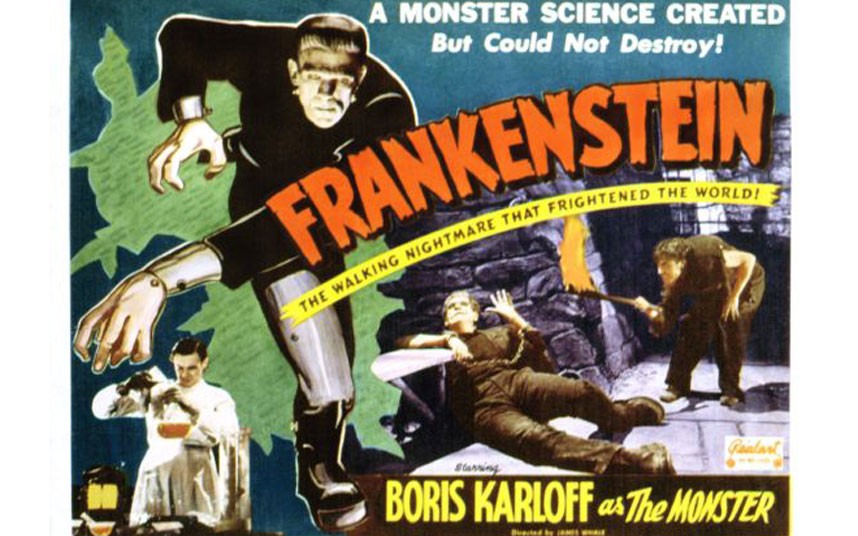Though not as organized and comprehensive as my Hammer Frankenstein post, this will be the first part in my small series of reviews covering the Universal horror movies. The small-scale plans are just to cover the shared universe (the Frankenstein, Wolf Man, and Dracula crossovers), but eventually I hope to tackled The Mummy movies, and some other treats of the era. So let's get started talking a little about the first Frankenstein from 1931, which is quite possibly the most important and influential horror movie in pop culture history.
Let's get the main points out of the way: I love Frankenstein. Boris Karloff is one of my favorite actors (though I never seem to remember to give him the credit that he deserves, because I'm an idiot), and this is the movie/performance that put him on the map. James Whale only ever directed 4 horror movies, which are all among the most important in the genre. In my eyes he's one of the top 2 or 3 greatest horror directors who ever lived. This is an incredible movie that has been covered thousands upon thousands of times, and if you don't know that you need to watch it by now, you're probably never going to realize this. So I'm just going to talk about how this movie shaped a pop culture icon, and leave some of the other bits to everyone else. The point is this: watch it.
It should go without saying that this stands as one of the greatest icons in the history of pop culture, but to those of you who are denial of this fact, just remember that pretty much everything you know about Frankenstein (assuming you haven't read the novel) is actually from this movie.
Firstly, the appearance of the Monster himself: in spite of being shot in black and white, his iconic green skin comes from the behind the scenes fact that horror makeup icon Jack Pierce used green grease paint in his design, as he felt it would give him a paler corpse-like appearance on-screen. Yes, this was the origin of the green skin we know the Monster for to this day. The flat-head was also an original design of Pierce's, with the Monster himself originally just being described as very tall (roughly 8 feet, specifically) and hideous in the book. It could be assumed he had stitches and was very disproportionate. Also, the bolts in his neck. In the novel, they never fully address the method in which the Monster was brought to life in the first place, with this adaptation establishing the use of thunderstorms and electrical gadgets attached to the metallic bolts on his neck. And these are just three examples of how this movie shaped the physical appearance of the Monster. Now we can talk about a few other things that this movie influenced and inspired.
The lumbering arm-extended "Frankenstein walk" did not originate here, with us first seeing this used in the early '40s when Bela Lugosi took over the role in Frankenstein Meets The Wolf Man -- a hugely influential movie in its own right. But that will come later. Most people know the Monster as being silent, with an awkward stumble and a heavy-footed walk, growling instead of speech. And yes, these things did indeed originate here. I also already mentioned the electrical gadgets and use of a thunderstorm to bring the Monster to life, but there's another aspect to this scary castle setting that I feel needs mentioned here: the hunchback assistant. The book doesn't give Dr. Frankenstein an assistant, and this movie does. While the name of this hunchback assistant is generally Igor in most of pop culture, his name here is Fritz. This is the only difference, as Igor would later be introduced in the series, but that will be talked about later.
As for the movie itself, this is one of the earliest talkie horror movies and mastered the use of sound, setting the bar for films to come. Watch this back-to-back with Dracula and the sound design differences are staggering. Dracula would have functioned nearly as well as a silent film (which could be expected, considering that's how all films had been made for 30 years up until the late '20s, right before it was made), with many scenes lingering in pure silence without use of music or peripheral noise. This works fine for it, as it's a quieter story in general but it does come across as relatively incomplete and a relic of a bygone era. Frankenstein, however, is filled with the whistling of wind through a spooky castle, the crackling of thunder, the snaps and whirring of gadgets, and only abstains from utilizing this sound when the story calls for it. It's a complete and appropriate design, that would only come to be matched by King Kong in 1933, which redefined the use of music in film of any genre. But that's a completely different discussion.
As a whole, it's important for younger audiences to watch movies like this. Though they don't hold up as particularly scary, appreciating and understanding the influence of films like this will be lost if people don't preserve them as the gems that they are. Sadly, this isn't the kind of movie that will be seen much playing on AMC, so don't rely on television to bring this one out for you. I highly recommend buying it and keeping it in your yearly Halloween horror rotation. Believe me when I say that it holds up. I've seen it at least a dozen times over the past 20 years and it's only gotten better in my mind.
Check back in later for my analysis of Bride Of Frankenstein, and its incredible visual effects provided by John Fulton. I almost want to talk about it right now, but I have to save it for later. Thanks for reading.

No comments:
Post a Comment